
|
 |
|
|
Last Updated: Aug 21st, 2020 - 13:06:35 |
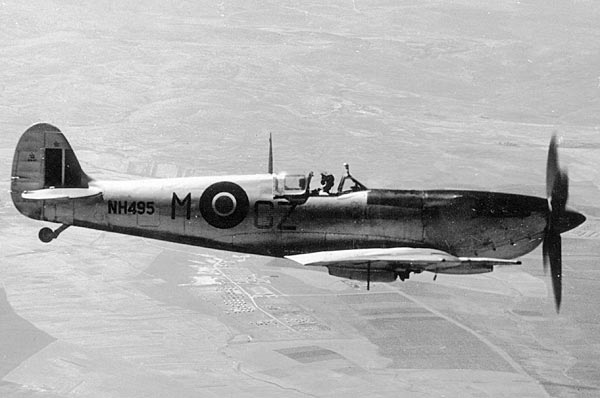 |
| A bare metal RAF 32 Squadron Spitfire Mk IX, post war. This 1945 photo shows Flying Officer John A Wall piloting NH495 over Ramat David where the Squadron was based until September that year. The Squadron was based at Ein Shemer in Palestine in May 1948 from where it moved to Cyprus. No. 32 Squadron did not leave this Spitfire behind, as a wreck, but others were. (J Wall) |
The Ventura Book ‘Spitfire - Star of Israeli’ covered some aspects of the Israeli Spitfire Story. This chapter presents more photos from our archives.
By the Spring of 1949, the Israeli Air Force was operating from three main bases - Ramat David, Hatzor and Akron. Hatzor was the main fighter base where the 101 Squadron Spitfires, Avia S-199s (usually referred to as ‘Messerschmitts’ by the Israelis) and the three surviving P-51D Mustangs operated from.
101 Squadron remained the sole fighter squadron until the formation of 105 Squadron in August 1950. Consolidation, following the end of the War and the departure of most foreign volunteers, called for a shift from Hatzor to Ramat David (with some personnel going to Akron) in June 1950. Hatzor was then handed over to Army control.
Until the formation of 105 Squadron (and 107 Squadron thereafter) 18 months after the War, 101 Squadron had to shoulder the full burden of air defence and other operational demands which included photo-reconnaissance. Israel’s geographical position made it vital that it be kept continually aware of the military capability and capacity of its Arab neighbours. Of particular importance were PR flights over the Syrian Air Force base at El Masa and the Egyptian Air Force base at El Arish.
A new Operational Training Unit (OTU) that was split off from 101 Squadron in December 1950 was given the title of 105 Flight, the genesis of what was to officially become 105 Squadron. While this OTU was primarily a training unit it could be called on for operational requirements at any time. Four months later, in April 1951, 105 Flight was officially changed to 105 Squadron. The squadron, while it operated Spitfires, was based at Ramat David.
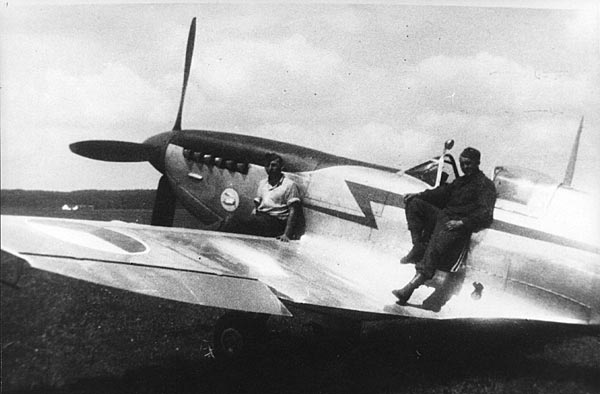 |
| Spitfire LF Mk IX TE515, later ‘Black 58’ in Israel, during its service as the Commanding Officers machine of the 4th Fighter Regiment, 2nd Air Division, Czechoslovakian Air Force, February 1946. (zlinek) |
 |
| Spitfire LF Mk IX TE515 |
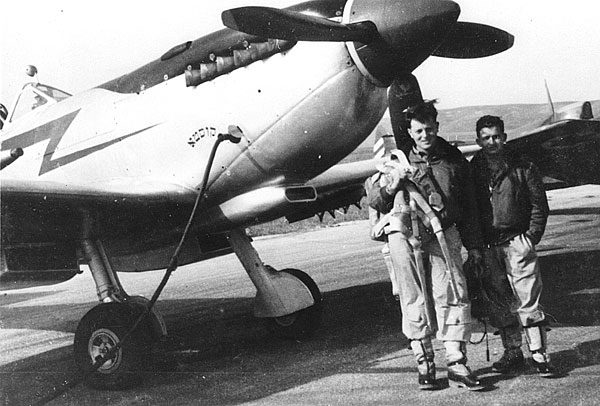 |
| TE515 in IDF/AF service. See coments by Zd. KLIMA below. |
TE515 in IDF/AF service. Right next to the electrical charging cable, it says "kost'a" in Hebrew.
It is the surmane of one of the Czechoslovak Jews who volunteered for enlistment to the new Israeli Air Force. His Czech name was Jan KOSTA and he graduated a special training course in elementary and advanced flying organized for the Israeli
Air Force by the Czechoslovak Air Force at Pilotni Skola III (No.III Pilot School) in Olomouc in the 2nd half of 1948. Then in the spring of 1949, he with other colleagues left Czechoslovakia for Israel and began using his Hebrewized name of Yo'el Kost'a. He was said to be a very good pilot and it is no suprise that he became a deputy commander
of No. 105 Squadron in mid-1951. It is very likely that he (as one of best pilots of squadron) used the silver ex-Czechoslovak Spitfire.
Before its sale to Israel, this plane was the personal machine of plk. Jaroslav HLA?O, a commander of 2. letecká divise /the 2nd Air Division/, based in ?eské Bud?jovice where pilots for Israel were trained in
1948.
Yo'el Kost'a died on 19 August 1951 in a fatal air accident as briefly described on page 108 of Ehud YONAY's book NO MARGIN FOR ERROR.
The ex 101 Squadron Spitfires that 105 Squadron inherited were soon joined by 30 ex-Italian Air Force Mk IXs. When 107 Squadron was deactivated, in March 1954, all of its Spitfires were passed on to 105 Squadron leaving it the sole Spitfire squadron (101 Squadron had transitioned onto Mustangs). The squadron continued to operate the remaining Spitfires, after thirty were sold to the Burmese government, until they were withdrawn from service in April 1956. Like 101 Squadron, 105 Squadron became a Mustang unit and operated these in the 1956 Suez campaign.
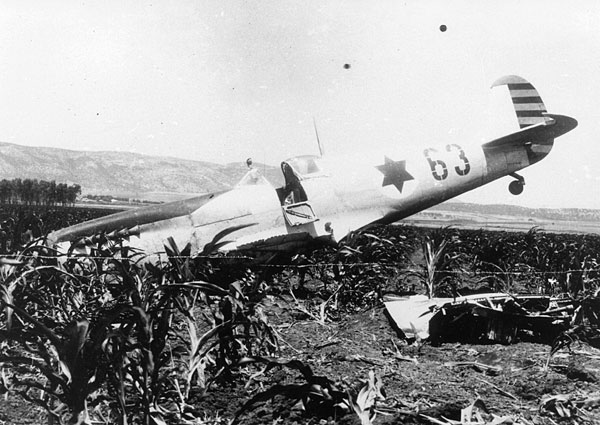 |
| This crashed Spitfire 105 Squadron, ‘Black 63’ is an ex-Italian aircraft and based at Ramat David in the mid 1950’s. It wears standard 105 Squadron, colours with yellow and black stripes rudder but does not have the Scorpion badge on the port side cowling. This ‘thin’ style of code number was only applied to 105 and 107 Squadron Spitfires (Yofe). All stenciling applied to Israeli Spitfires was in Hebrew and a direct translation from the English it replaced. (photo, Levy) |
107 Squadron
In November 1953, a second OTU was established at Ramat David with the two-fold purpose of keeping reserve pilots skills up and operational training for new pilots. Named 107 and equipped with the now obsolescent Spitfire it existed for barely five months.
It was the intention of the Air Force Command to upgrade 105 Squadron from an OTU over to a fully fledged fighter squadron, leaving 107 Squadron as the sole Operational Training Unit. Most of the ex-Italian Spitfires were allotted to 107 Squadron along with 101 Squadron’s surviving Spitfires after that Squadron converted fully to Mustangs.
The purchase of British manufactured jet fighters, by a number of Arab Air Forces in the early 1950’s motivated Israel to do the same and the first Gloster Meteor F.8 arrived in June 1953. Training priorities therefore changed with an emphasis on conversion-to-jet training. With this in mind, the IAF/FD Command decided that it was not necessary to keep two piston-engine fighter squadrons and so, in March 1954, 107 Squadron was merged into 105 Squadron which became the only Spitfire unit.
Even though it was in existence only a short few months, 107 Squadron still received squadron colours (blue & white) and a badge. This was not the end for the squadron, however, as it was reformed after the 1956 Suez conflict.
Ex Italian Spitfires
When Allied forces left Italy in June 1947, the RAF left behind about 140 Spitfire Mk IXs. These were refurbished and operated by the Italian Air Force together with other piston engine types until jets took over in the early 1950’s.
In Israel at this time, a need was felt for additional Spitfires for operational training units and the government had also budgeted for two new fighter squadrons in 1952. This was still before the introduction of jet fighters into the Middle East changed operational thinking.
Thus the Italian offer was most fortuitous and a meeting was arranged in September 1951 between a team from the Israeli Defence Ministry and the Italians. By March of the following year, a contract was signed for the supply of 30 LF Mk IX airframes plus an extra twenty Merlin engines and a quantity of spares.
Most of the aircraft were in good condition and an Italian company, Ambrosini, was contracted to refurbish any that weren’t. The ferry flights to Israel were flown by Italian pilots and the last aircraft were delivered by June 1952.
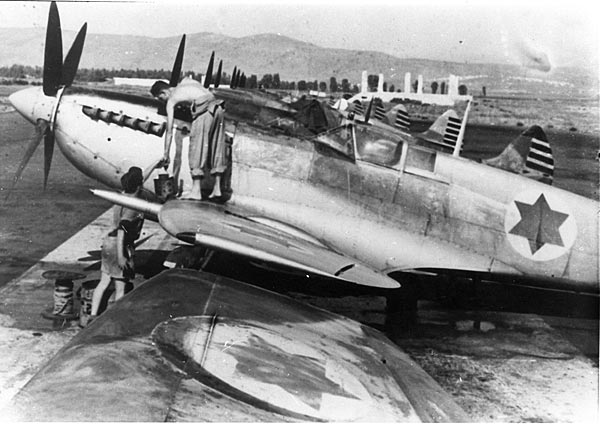 |
| A lin-up of IDF/AF Spifires very late in their service life. (Levy) |
Throughout their service with the Israeli Air Force the ex-Italian Spitfires remained instantly identifiable by the unique Italian applied black anti-glare panel as most were never camouflaged.
New colours
In 1955 a dark blue and brown, with light grey lower surfaces, camouflage scheme was introduced. With the last Spitfires going out of service in 1956 a few were repainted in this scheme and ‘03’ is an example.
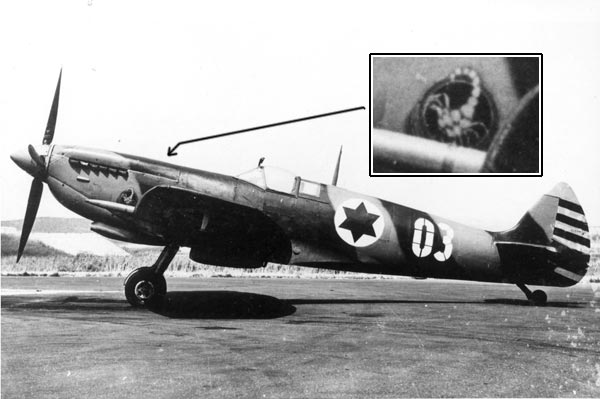 |
| A Spitfire LF Mk IXe of 105 Squadron at Ramat David December 1953.* This is an ex-Czech Spitfire and looks freshly painted in the Israeli Air Force dark blue and brown scheme with light blue-grey lower surfaces. It appears to have only a partly applied 105 squadron ‘Scorpion’ badge. (Levi). |
 |
| The repainted White 03. According to Air-Britain's "Spitfire International," the original serial is unknown. When it first arrived, it was D-132, arriving 27-9-48, via Operation Velveta I ferry flight. Originally, as D-132, it went to 101 Squadron. Late 1948/early 1949 renumbered as "12." Went to 105 Squadron August 1950, crashed, on landing 14-1-51, and went to 22 Wing/MU. Another accident 1-3-51, and again (Cat.E) 25-12-53, and written off March 1954. (Caption Info from Edgar Brooks, Marlow UK) |
© Copyright 2004-2015; VenturaPublications.com and contributors.
Top of Page
|
|
 |

|

